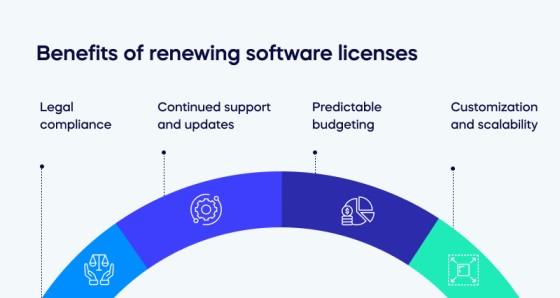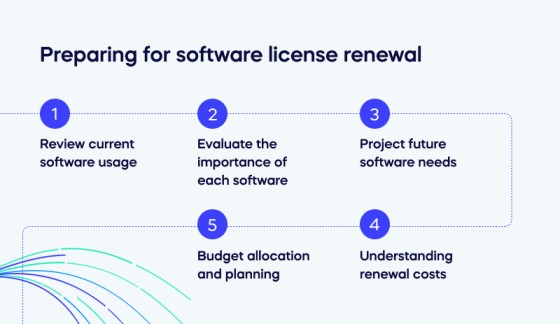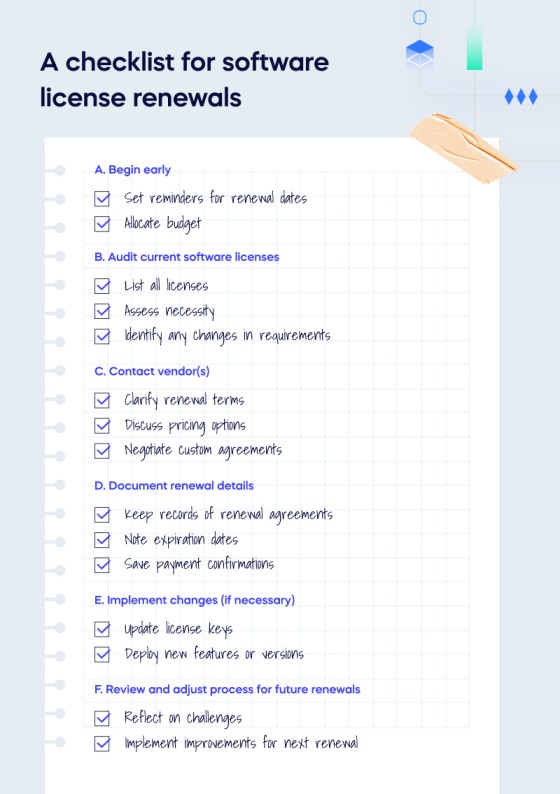Software license renewal is the process of extending the term of a software license agreement.
It’s a process that often gets left unchecked, but doing so can result in your business shelling out heaps of cash on software you don’t need.
On top of that, you have to think about compliance, security, and support- balancing all of these factors depends on a robust software license renewal strategy.
It can sometimes feel like a chore but do it right, and you could turn software license renewal into a powerful cost-cutting tool. Thus, license renewal is critical to your overall SaaS management strategy.
This article will show you how to nail software license renewal.
We’re explaining everything you need to know. By the time you’re done reading, you’ll learn how to prepare and what to expect from the process, and we’re providing you with a checklist you can use to make sure you never miss a trick.
Software license renewal- what it is and why it’s a necessity
Essentially, software license renewal extends your company’s right to use a particular software application beyond the initial licensing period.
This could involve updating the contract, adjusting the number of users, or upgrading to a more comprehensive package.
Why should you bother renewing software licenses?
Well, as your business grows, your software needs will evolve.
Renewing licenses ensures that your company remains compliant with legal requirements and continues to benefit from the software’s features, security, and support.
It’s also an opportunity for re-evaluation: Are you using the right tools? Are there more efficient or cost-effective options available?
Common terms and types of software license renewals
Understanding the different types of licenses is critical in making the right choices for your business.
Here’s a breakdown:
Perpetual licenses
This type of license allows your business to use the software indefinitely.
However, you might need to renew maintenance contracts to receive updates and support.
Subscription licenses
Your business pays a recurring fee with subscription licenses, often monthly or annually.
You’ll need to renew regularly to continue using the software.
Enterprise licenses
These are designed for large organizations.
Enterprise licenses usually allow for unlimited use of the software throughout the company and come with a higher level of support.
Named user licenses
This type of license is assigned to specific users within your business.
It’s ideal when only a few team members need access to the software.
Benefits of renewing software licenses

Here’s what’s in it for you when you make the right choices about software license renewal:
- Legal compliance: Renewing keeps your business compliant, avoiding fines and legal complications.
- Continued support and updates: You can access the latest features and security patches.
- Predictable budgeting: Knowing your renewal dates and costs can help in budgeting and financial planning.
- Customization and scalability: Renewal negotiations can enable customization or scaling of licenses as per business needs.
Consequences of not renewing software licenses
On the flip side, if you don’t have a good software license renewal strategy, here’s what could go wrong for you::
- Legal trouble: You might face legal repercussions or fines for using software without a valid license.
- Security risks: Without updates, your systems could be vulnerable to security breaches.
- Loss of productivity: Unsupported software can become unstable or incompatible with other systems.
- Damage to reputation: Being known for non-compliance or having security breaches due to outdated software can harm your brand image.
Understanding the ins and outs of software license renewal is crucial to ensure your company operates smoothly, remains compliant, and utilizes the most effective tools for success.
Preparing for software license renewal

Before you kick off the software license renewal process, you should do a little preparation by reviewing the following:
- Your current licensing needs
- Any budget considerations
Doing this prep will help a lot when it comes down to making decisions and negotiating with vendors.
We’ve broken the preparation process into five steps to prepare you for software license renewal.
They are:
- Review current software usage
Before diving into the renewal process, take stock of your business’s software.
Check how many licenses you have and who’s using them. Are there any licenses that are underutilized or not used at all?
Gathering this information helps you make informed decisions.
- Evaluate the importance of each software
Not all software is created equal.
Some tools might be critical to your day-to-day operations, while others are not as essential. Rank the software based on its importance to your business.
This will help you prioritize and decide how to handle resource allocation during the renewal process.
- Project future software needs
As your business evolves, so do your software needs.
Consider any upcoming projects or expansions and how they might impact your software requirements. Will you need additional licenses or different types of software?
Thinking ahead is key.
- Understanding renewal costs
Next, you need to get a handle on the costs associated with renewing your software licenses.
This might include not only the license fee itself but also any maintenance or support fees.
Also, consider whether the vendor might offer discounts or incentives for renewing and whether the costs have changed since the last renewal.
- Budget allocation and planning
Now that you have a clear picture of your licensing needs and the associated costs, it’s time to allocate the budget.
Based on the importance of each software, distribute your IT budget to maximize your business’s value.
Make sure to plan for future renewals by setting aside funds in advance. This ensures that you don’t face any financial hiccups when it’s time to renew.
The renewal process
Here’s a rundown of a software license renewal’s typical steps.
Familiarizing yourself with these now will help you feel more comfortable handling renewals later.
Understanding renewal notifications
Vendors usually send out renewal notifications when it’s time to renew your software licenses. Watch for these notifications in your email or through the software itself.
These alerts are important because they inform you of upcoming expiration dates and often include instructions or links to initiate renewal.
Ensure your contact information is up-to-date with all vendors to ensure you don’t miss any important notifications.
Renewal timeframes and grace periods
Knowing when to renew is key.
Each vendor may have a different timeframe within which you need to renew the software license. Some might send notifications several months in advance, while others only give you a few weeks’ notice.
Also, be aware of any grace periods after the license expires. During this period, you may still be able to renew without losing access to the software.
Understanding these timeframes clearly helps you plan accordingly and avoid any service disruptions.
Communicating with vendors
Communication with vendors is an essential part of the renewal process.
If you have questions about the renewal or need to change your license agreement, don’t hesitate to contact the vendor.
Establishing a good rapport with your software vendors can also be beneficial in receiving better support and possibly even negotiating more favorable renewal terms.
Negotiation strategies for renewal terms
Don’t just accept the first renewal offer that comes your way.
This is an opportunity to negotiate. Here are some strategies you can use:
Leverage your history: If you’ve been a loyal customer, use this to negotiate better terms.
Bundle licenses: If you renew multiple licenses or products from the same vendor, ask for a bundle discount.
Be willing to commit: Sometimes, agreeing to a longer-term contract can get you better rates.
Know the market: Be informed about what competitors offer, and don’t be afraid to use this information in your negotiations.
Negotiating with vendors can be daunting at first. If you want to dive deeper into negotiation strategies, check out Gartner’s top 3 strategies to cut software and cloud costs.
Completing the renewal process
Once you’ve got the terms you want, it’s time to finalize the renewal.
Carefully review the renewal agreement to make sure everything aligns with what was discussed. Pay attention to the details, including the number of licenses, the duration, and the costs.
Once satisfied, complete the payment, and keep a record of the renewed agreement.
Also, note the next renewal date so you can start the process in a timely manner the next time around.
Do you need a license management tool?
Managing software licenses, especially in a business environment where you might have dozens or even hundreds of licenses, can be a complex task.
License management tools are designed to make this process easier and more efficient.
These tools help you keep track of all your software licenses, monitor usage, receive notifications for upcoming renewals, and often even assist in the renewal process itself.
They can be standalone applications or modules within broader IT asset management solutions.
License management tools are growing in popularity, with Gartner predicting that 50% of organizations will have centralized SaaS application management by 2026.
Here are a few reasons why you might want to justify the additional expense of a license management tool:
Centralized tracking: You can track all your licenses in one place, making it easier to get an overview of your software assets.
Automated notifications: These tools can automate renewal notifications, ensuring you never miss a deadline.
Compliance maintenance: They help ensure your business stays compliant by managing licenses effectively.
Cost savings: By providing insights into software usage, license management tools can help you identify and eliminate redundant or underutilized licenses, saving costs.
Efficient renewals: Some tools streamline the renewal process, allowing you to renew licenses directly through the platform.
Building business resilience with software license renewal
The last few years have been full of uncertainty and disruptive change.
More and more leaders are looking to tighten their pursestrings to build business resilience and ensure they have the resources to outlast an economic downturn. If you feel the same way, reassessing your software license renewal process is a good place to start.
Even the experts agree with the wisdom of this.
“IT sourcing, procurement, and vendor management (SPVM) leaders must take immediate action to alleviate financial pressure for a six- to 24-month period,” says Gartner Senior Director Analyst Stephen White late last year. “Leaders need to protect their organizations from financial disruption and build resilience for what may yet be to come.”
With the information in this guide, you’re armed with everything you need to turn software license renewal from a necessary chore to a cost optimization exercise that leaves you with a cheaper, cleaner, simpler tech stack.
And on that final note, here’s our software license renewal checklist for ease of reference or printing.
This checklist is a guide to ensure you efficiently and effectively manage software license renewals, keeping your business compliant and your software tools up-to-date.
A checklist for software license renewals

A. Begin early
- Set reminders for renewal dates
Start by setting up reminders for the renewal dates of all your software licenses. This will give you ample time to prepare for the renewal process.
- Allocate budget
Begin budget allocation early to ensure you have the necessary funds for renewal. Estimate the costs and make adjustments as needed.
B. Audit current software licenses
- List all licenses
Create a comprehensive list of all the software licenses your business holds. Include details such as the number of users, license type, and expiration date.
- Assess necessity
Evaluate the importance of each software license to your business operations and identify any that may no longer be needed.
- Identify any changes in requirements
Determine if there have been changes in your business that might affect your software requirements. This could include expanding your team or changing business strategies.
C. Contact vendor(s)
- Clarify renewal terms
Reach out to the vendors to clarify the terms of renewal. Understand what is included in the renewal and if there are any changes from the original license.
- Discuss pricing options
Ask about different pricing options available for renewals. Sometimes there are discounts or special offers that you can take advantage of.
- Negotiate custom agreements
If you have special requirements or need flexibility in your license, negotiate with the vendor for a custom agreement that suits your business needs.
D. Document renewal details
- Keep records of renewal agreements
Once the renewal is complete, keep a detailed record of the renewal agreement. This documentation is crucial for future reference and compliance.
- Note expiration dates
Record the new expiration dates of the licenses and set reminders for the next renewal cycle.
- Save payment confirmations
Make sure to save receipts or confirmation emails of your payments for renewal. This can be important for accounting and financial reporting.
E. Implement changes (if necessary)
- Update license keys
If the renewal process involves new license keys, update them in your system.
- Deploy new features or versions
Renewal might come with updates or new features. Plan the deployment of these updates in a way that causes minimal disruption to your operations.
F. Review and adjust process for future renewals
- Reflect on challenges
After completing the renewal process, take some time to reflect on any challenges or hurdles you faced.
- Implement improvements for next renewal
Based on your reflection, implement any necessary improvements to make the next renewal process more efficient.


